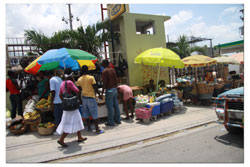|
| ||||||
| Rebuilding Haiti
by Will Sands
When the 7.0 magnitude earthquake struck 10 miles from the Haitian capital of Port-au-Prince, it claimed 230,000 lives and left millions without homes. Relief immediately poured in to the ravaged country in the form of food, water, medicine, funds and temporary shelter. However, four months later, more than 2 million Haitians are still homeless, and the coming rainy season promises to exacerbate the problem. “There’s no shortage of food or clothing in Port au Prince,” said Booth, who returned from the country last week. “There’s abundance and there’s a tremendous amount of commerce. The city itself is actually very vibrant. However, a lack of housing is the issue, and there’s still a need for the international community to maintain a strong medical presence in Haiti.” Based in San Diego, International Home Exports is a global supplier of complete steel home and building packages. The company is geared toward meeting world demand for affordable housing with buildings that have the integrity to withstand the Earth’s most challenging forces. Booth, who has worked as a Realtor with Coldwell Banker and Prudential in Durango, first got involved with IHE in the mid-’90s. In recent years, he set up the company’s sales and marketing department in Durango. “This was always my first love,” he said. “I worked real estate in Durango until the company took off.” Shortly after the quake, IHE received a call from Miami resident Chantal Banatty. Banatty’s husband, Louis, had died in the quake and she wanted to leave a testament to the Haitian-American businessman and founder of Miami’s Radio Creole. Chantal proposed developing a large swath of land adjacent to Port-au-Prince with affordable homes. Her motive was to help solve the Haitian housing crisis, and she asked if IHE was up to the challenge. “The Haitian government can’t pick it all up,” Booth said. “Private development has to step in, and by doing so, it will create jobs and revitalize the country. At IHE, we have the engineering, logistics and years of experience to be able to deliver a quality product to Haiti at an affordable price. The bottom line is the Haitian government needs a solution, and we’re bringing it to them.” Booth will be back in Port-au-Prince next week and doing his best to answer a challenging question – “How do you build housing for 2 million homeless people?” He will be accompanied by Manon Campagne, a 21-year-old student in international business from Lille, France, as he sets up shop. Once the process gets rolling, he will be looking to the Haitian people to do most of the heavy lifting.
“We bring a vision for and appreciation of how to redevelop a country using its own sense of community,” Booth said. “These people are not refugees. The fact is there are 2 million homeless people who get up every morning and go to work or school.” IHE will be looking to Haiti’s government to be the backbone of the effort. Tens of thousands of government employees and state police officers are themselves homeless, according to Booth, and the on-the-ground construction will be done by Haitians. The work should be under way in a matter of days. “If all goes as planned, I’ll be down there at the end of this week signing contracts and we’ll start building in 30 days,” Booth said. “Within the next couple years, we’ll be building tens of thousands of homes in Haiti and reconstructing schools, office buildings and clinics.” During his recent trip to Haiti, the IHE plan was well received, and Booth pitched it to the Haitian Minister of the Interior, the country’s Director of World Vision and the Chief of the National Police, among others. “Doors flew open,” Booth said. “I was received very well, and when officials saw what we were bringing to the table, they were ecstatic.” For her part, Campagne is also ecstatic and excited to begin what promises to be an “adventurous internship.” “It’s a very important project and at the same time a real opportunity to offer much needed assistance to Haiti,” she said. “I hope I can bring something to the effort.” Reflecting on his recent trip to Haiti, Booth encouraged Americans to look beyond the images and stories of death and devastation. Instead, he painted a picture of optimism and recovery. He noted that the country is pulling itself up and only needs a nudge from its neighbor to the north. “I would encourage people to remain focused on Haiti,” he said. “In our society, it’s so easy to move onto the next story, but Haiti still needs us. U.S. involvement and U.S. investment will be essential to getting this country back on its feet.” • Durangoans can follow the progress of the IHE effort online at: www.rebuildinghaitinow.com.
|



 On Jan. 12, a massive earthquake devastated Haiti and rattled the world. Though the disaster has moved off the front page, the country remains in distress and millions of Haitians are still without housing. A Durangoan, who made his name locally by selling housing, is rising to this challenge. Joe Booth, now the director of sales and marketing with International Home Exports, is working to get hundreds of thousands of displaced Haitians into affordable, well-built homes.
On Jan. 12, a massive earthquake devastated Haiti and rattled the world. Though the disaster has moved off the front page, the country remains in distress and millions of Haitians are still without housing. A Durangoan, who made his name locally by selling housing, is rising to this challenge. Joe Booth, now the director of sales and marketing with International Home Exports, is working to get hundreds of thousands of displaced Haitians into affordable, well-built homes.
